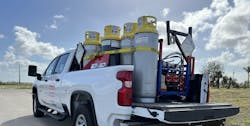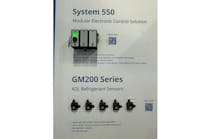As environmental regulations tighten and refrigerant management becomes more complex, HVAC contractors face increasing liability risks tied to improper tracking and documentation. From potential EPA fines to legal exposure and insurance complications, understanding the nuances of refrigerant tracking is more critical than ever. We sat down with Adam Dykstra, CFO of FM Hero, who breaks down the key compliance requirements, common pitfalls, and best practices contractors can follow to protect their business and stay ahead of evolving regulations.
CB: What are the key EPA regulations HVAC contractors must follow regarding refrigerant tracking?
AD: Key refrigerant tracking regulations are embedded in section 608 of the Clean Air Act and the ER&R portion of the AIM Act. The easiest way to think about refrigerant tracking regulations is like we do with financial accounting. Every pound a contractor purchases needs to be tracked through inventory and to its destination — in essence, every pound tracked from purchase through inventory and to the unit it was charged into. Likewise, with every pound recovered and sent to a wholesaler or directly to a reclaimer.
CB: How have refrigerant laws changed in recent years, and what should contractors be aware of in 2025?
AD: The regulatory landscape is ever-changing. Near the end of 2024, the ER&R (Emissions Reduction and Reclamation) portion of the AIM Act was finalized. Documentation is key, and contractors and individual technicians need to be aware of what they're documenting and how, and be prepared to show an accounting.
In August 2023, the EPA stated, "For the first time, we will focus enforcement and compliance resources... on noncompliance with the Clean Air Act and the American Innovation and Manufacturing Act,” as its enforcement target from 2024 through 2027.
CB: What are the penalties for improper refrigerant tracking or handling?
AD: The results of non-compliance are steep and can amount to more than $52,000 per day/violation. This can also include revocation of an individual’s EPA certification, resulting in no longer being able to work in the industry or purchase refrigerants. An organization's public branding is also negatively affected by bad press, as the EPA publicly publishes violators.
Often, these enforcement actions happen behind the scenes and can take three to five years to complete. No one is sharing their dirty laundry on the golf course, so we won't know how widespread the impact of this new enforcement initiative will be until well after the die has been cast.
To date, there have been technicians, contractors, scrappers, wholesalers, importers, manufacturers, and reclaimers who have violated the rule. In short, there isn't a segment of the HVACR industry that hasn't been touched by enforcement, and all of which occurred before this new focused enforcement initiative.
CB: Are there specific state or local regulations that differ from federal laws?
AD: No state can have less stringent regulations than the Federal law, but several states have enacted far more restrictive regulations.
CB: What are the biggest liability risks HVAC contractors face regarding refrigerant handling and tracking?
AD: Two major liability concerns arise surrounding these new regulations.
First, a lack of training and knowledge results in confusion over the rules and best practices. Are you and your team handling, transporting, and installing safely? A2Ls are perfectly safe when handled appropriately, and safety is everyone's responsibility — get trained, work safely, and teach your team how to do so, as well.
Second, if you can't prove it, you didn't do it. A lack of adequate documentation on all refrigerant transactions is a lurking risk — one often ignored until it's too late. Today, everyone carries a high-definition video camera in their pocket, it only takes one disgruntled employee or nosey neighbor to video something they believe is suspect. In a subsequent investigation, your ability to prove your historic transactional compliance is key. If you can't prove it, you didn't do it — documentation is your defense.
CB: How can contractors protect themselves from legal action related to improper refrigerant management?
AD: Every contractor needs an accurate system of documenting all refrigerant transactions, recording the chain of custody of refrigerant moving through their organization, and maintaining these records for three years to meet EPA requirements.
Tracking refrigerant movements includes initial inventory, every purchased pound of gas, every charge event, and final handling of all cylinder vapor heels. Every pound needs to be documented — even in the event of loss from theft, damage, or mechanical failure of a cylinder or system.
CB: What role does documentation play in reducing liability risks?
AD: Accurate and correct documentation that meets EPA requirements will save the contractor from further scrutiny by the EPA.
CB: How does poor refrigerant tracking impact insurance coverage and claims?
AD: Insurance covers accidents, not intentional acts. Don’t expect insurance to cover fines or attorney’s fees that result from enforcement actions.
A side benefit of having detailed documentation is that it enables you to prove your inventory in the event of a claim. Knowing exactly how much new and recovered refrigerant is on each service vehicle and at your facility is critical to getting fully reimbursed in an insurance claim.
CB: What are the most common mistakes HVAC professionals make with refrigerant tracking?
AD: First, no one likes paperwork. In our industry, too many of us bury our heads in the sand and think that refrigerant tracking and documentation is “not their job.” Technicians, contractors, equipment owners/operators, scrap yards, manufacturers, importers, and wholesalers all have documentation requirements in the regulations.
Second, there is a misconception that “the EPA will never come after me.”
Third, they don't have an accurate, transactional documentation system that meets EPA requirements and makes audits less painful.
Lastly, field to office inaccuracies, and contractor to client inaccuracies — each party involved needs their records to match.
CB: How does proper refrigerant tracking affect business profitability?
AD: Properly tracked refrigerant ensures every pound purchased is used and sold. How valuable is ensuring ‘no pound is left behind’ or goes missing out the back door? The same applies to recovered gas. Even recovered gas has significant value, and way too many contractors are leaving money on the table.
CB: How might new refrigerants and alternatives impact tracking requirements?
AD: The move to lower GWP refrigerants is underway. We’ll have to wait and see what refrigerants will win the future, but in the meantime, regulations are getting more and more restrictive, and tracking and documentation are a must. No matter what happens in the future with regulations, tracking refrigerants makes financial sense.
CB: Anything else you would like to add?
AD: The amount of change in our industry is staggering. Keeping up with new technologies, customer expectations, regulatory changes, and a tightening workforce leaves everyone exhausted and often frustrated. We’re grateful that so many are stepping forward to help educate and inform and to lead HVACR technicians and contractors into the future. If there are any ways our team can help, please let us know!














